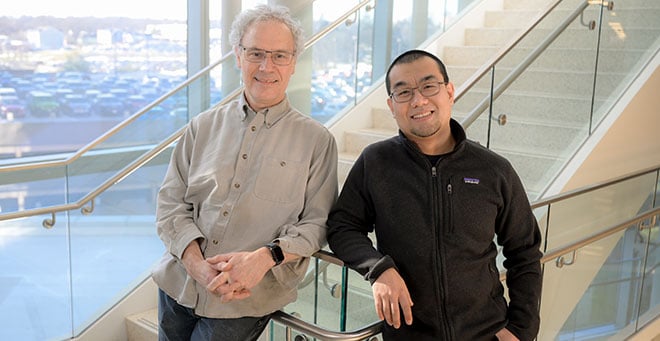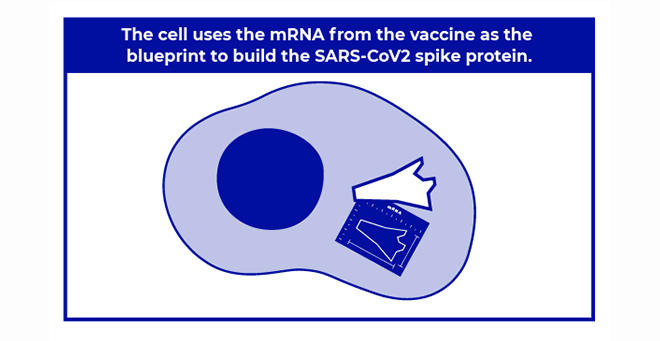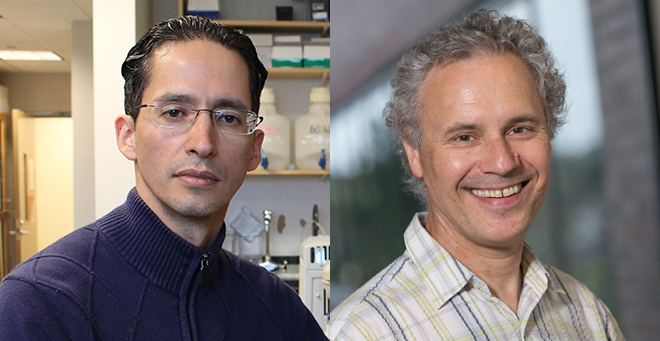
Research by Victor Ambros, PhD, provides new insights into a recently identified class of neurodevelopmental disorders called Argonaute syndromes. Dr. Ambros and colleagues believe their Proceedings of the National Academy of Sciences paper will help inform clinical and translational researchers in their pursuit of a treatment for this class of neurodevelopmental and autism-spectrum disorders.
“These findings will help the clinical scientists studying Argonaute syndromes in human cells to test for similar biological mechanisms,” said Ambros, the Silverman Chair in Natural Sciences and professor of molecular medicine. “Much of basic biology is shared between organisms. The power of the C. elegans model is that we can learn something new about basic biology that can then be applied directly to humans and human disease. Our work uncovers potential new aspects of Argonaute function in humans that then can help guide the search for treatments for disease.”
A central figure in ribonucleic acid (RNA) biology research, Ambros was the first person to identify and characterize a known microRNA, a class of noncoding RNAs that plays an important role in modulating or regulating gene expression, specifically the process by which genes are silenced or turned off. Today, the discovery of microRNA is recognized as a pioneering step toward understanding that many RNA molecules play a critical role in the complex regulation of genes.
In this new study, Ambros and colleagues show that the RNA silencing complex is globally disrupted by single amino acid changes found in mutations associated with the newly identified Argonaute syndromes. These genetic mutations, studied in the C. elegans model, cause an organism-wide disruption of microRNA levels and messenger RNA translation, impacting hundreds of different genes, some of which are associated with neurodevelopmental disorders.
At a glance |
|---|
|
The Argonaute protein family consists of four proteins in humans, AGO1, AGO2, AGO3 and AGO4. First discovered for their evolutionarily conserved function in stem cells and development, these proteins play a central role in the RNA silencing process. Found in C. elegans, the microscopic worms scientists use to study basic biological processes, as well as humans and all animals, the Argonaute protein family has the same job—inhibit gene expression.
Argonaute proteins are the active part of the RNA-induced silencing complex (RISC), which degrade or cleave messenger RNA (mRNA) strands or inhibit their translation into proteins that would otherwise lead to protein production. The Argonaute protein targets complementary strands and reduces protein production by limiting the amount of mRNA or their translation efficiency found in the cell.
A complex biological molecule, Argonaute proteins have been associated with certain cancers, male infertility and neuronal development disorders. In 2021, a team of researchers led by Amélie Piton, PhD, associate professor of genetics and pathophysiology in neurodevelopmental disorders at the Institute of Genetics, Molecular and Cellular Biology in Strasbourg, France described the first Argonaute related syndrome in humans caused by a mutation in the AGO1gene. Meanwhile, a team led by Davor Lessel, MD, PhD, head of the Institute of Human Genetics at the University Hospital Salzburg, and Hans-Jürgen Kreienkamp, PhD, professor of human genetics at University of Hamburg, discovered in 2020 an AGO2-related syndrome, also known Lessel-Kreienkamp or Leskres syndrome.
Argonaute syndromes are extremely rare. To date, only 85 cases of Argonaute syndrome have been found in humans. These syndromes are characterized by a range of intellectual and physical symptoms including problems speaking and understanding language, delayed motor development, frequent seizures and cognitive impairment. Many patients exhibit autism spectrum-like pathologies.
Using C. elegans and CRISPR/Cas 9-mediated genome editing, Ye (Oscar) Duan, PhD’23, a postdoctoral researcher in the Ambros lab and the study co-author, probed four human AGO1 mutations by introducing the same mutations in the worm’s AGO1 counterpart. Results showed that mutations that change the function of the AGO1 gene exhibit stronger effects than mutations that completely turn off the AGO1 gene.
Duan explained that these results suggest that the mutant protein competes or interferes with the functions of the other, healthy Argonaute proteins such as AGO2. “This disparity occurs, we think, because in the complete absence of AGO1, the other Argonaute proteins, such as AGO2, step in and pick up the slack. Everything continues to operate normally,” said Duan. “But in the case of these single amino acid changes, the AGO1 protein being produced is aberrant and somehow keeps the RNA silencing process from happening, most likely by sequestering functional components of the microRNA silencing complex.”
The result is a cascade of perturbations in global gene expression that impact microRNA levels and messenger RNA translation throughout the organism. Many of the genes impacted, according to Duan, have been linked to neurodevelopmental disorders in humans.
The next step for clinical and translational researchers will be to identify how these mutations are causing the microRNA silencing complex to misfire.


